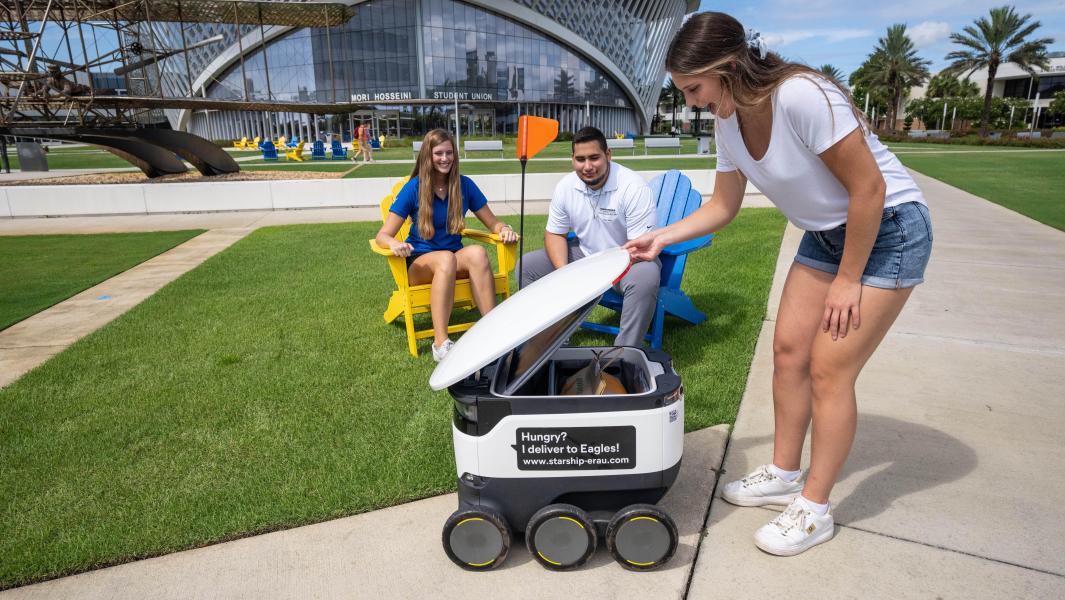Robotics company Starship Technologies is reshaping our shopping and delivery habits, bringing green innovation to urban mobility
Imagine this: you just came home from work and you are hungry. So, you decide to order some food online. After patiently waiting for thirty minutes, you receive a notification, your food is finally here. But when you open your door, there’s no one there. Instead, when you look down, you see a futuristic-looking, white robot the size of a shopping basket.
This might sound like science fiction, but it is already a reality for many consumers in Estonia, Finland, Denmark, the United Kingdom and the United States. The small and stylish robots can deliver groceries, food, drink and other items to nearby communities and on campuses.
Behind this innovation is Starship Technologies, a company founded in 2014 in Estonia by the co-founder and chief architect of Skype, Ahti Heinla and Janus Friis. Since then, the company has completed over 3.5 million commercial deliveries, covering a distance of more than 7 million km globally, more than any of its competitors.
“We are revolutionising the way we do shopping and delivery,” says Pol Oliver, the chief financial officer of Starship Technologies. “The robots will free us from wasting time, energy, and emissions on tedious daily chores and journeys in an efficient and sustainable way.”
Delivery robots from the future
Sci-fi has some scary robots. Who can forget HAL 9000 in Stanley Kubrick’s 2001: A Space Odyssey or Arnold Schwarzenegger in James Cameron’s The Terminator? But this is not the case for Starship’s robots, which have more of an R2D2-like charm. “When first seeing the robots, children and people want to either interact, greet or take pictures with them” says Starship’s Henry Harris-Burland. “But one of the biggest compliments we see, is how quickly Starship robots become the new normal and part of daily life for the community.”
But don’t let their cute looks fool you- these robots are tough and can operate through just about anything. They might be 55 centimetres tall and weigh around 35 kilograms, but they can deliver up to three bags of groceries, food and drink. Thanks to their twelve cameras and six wheels, the robots can also climb kerbs, avoid objects, move out of the way of nearby pedestrians, and even detect obstacles, like moving cars up to 300 metres away.
Starship’s robots can make deliveries smarter, too. Electric powered and guided by a combination of sensors, artificial intelligence and machine learning, while computer vision-based navigation helps them map their environment to the nearest centimetre, they can identify the shortest and safest routes, reducing significantly the time and carbon footprint of deliveries. “The average Starship delivery uses the same amount of energy that a kettle needs to boil water for just one cup of tea,” says Harris- Burland.
What is an autonomous vehicle?
An autonomous vehicle is a vehicle that is able to operate itself, sense its environment and perform essential functions without human involvement.
How do autonomous vehicles work?
Autonomous vehicles rely on sensors, actuators, complex algorithms, machine learning systems, and powerful processors to execute functions. For example, they use video cameras to detect traffic lights, read road signs, track other vehicles, and look for pedestrians. All the inputs from the sensors and cameras are processed by the software, which then sends instructions to the motor, brakes, steering, and actuators controlling the acceleration. Algorithms and hard-coded rules help the software follow traffic rules and navigate obstacles.
What are the benefits of autonomous delivery vehicles?
Automation can:
- Reduce pollution and emissions
- Reduce traffic congestion on roads
- Improve last-mile delivery services
- Reduce transportation costs
- Lower costs and maintenance
- Improve transport interconnectivity
Venture debt means more innovation in Europe
Everything started with rejection. Co-founder Ahti Heinla’s involvement with robots started when he led a project building an autonomous rough-terrain robot for a NASA competition. His design did not make it to Mars – but then, a new idea came. What if we use such robots to make autonomous deliveries here on Earth?
The idea might have seemed out of this world at the time - after all, there were no other similar companies. “One of the key insights that made Starship’s founders shift to deliveries was the discovery that up to 50% of total transportation costs are weighted in the last couple of miles and autonomous robots could make a huge positive impact to reduce costs and increase efficiency,” says Harris-Burland.” Also, 95% of the things people order online are small enough to fit in a smallish delivery robot.”
Today, Starship Technologies has offices in the United States, London, Finland, Germany, and an R&D lab employing more than 100 engineers in Tallinn, Estonia.

The European Investment Bank is backing the company with a €50 million quasi-equity venture loan, signed in January this year. This financing, supported by the European Fund for Strategic Investments, is part of the European Growth Finance Facility (EGFF), a product designed to address the dearth of venture capital for innovative start-ups in Europe.
“High-technology companies often face issues with access to long-term financing,” says Trudpert Schelb, a sector expert at the European Investment Bank. “This is where venture debt tools like the EGFF matter. They help young companies to not only achieve technological breakthroughs but also bring those technologies to the market and realise some of their commercial potential and socio-economic benefits.”
For Starship, the Bank’s financing means more engineering resources for research and development, more robots, and more deliveries and innovation in Europe. “We are excited about launching in other European countries,” says Oliver. “We are a deeply pan-European project.”
Learn more about venture debt:
Delivering greener and more innovative solutions
Starship’s robots are changing the options for last-mile delivery in Europe and the rest of the world. “You’ve got delivery vans stopping hundreds of times each day outside houses, missed delivery slips piling up in letterboxes, and big cars delivering small pizzas,” says Harris-Burland. “This makes deliveries costly and harmful for the climate, ecosystem and the urban environment.”
Delivery robots can also play a clear role in the sustainable transport puzzle. With freight transport being a big source of pollution in many cities, Starship’s delivery robots can reduce congestion and harmful emissions in the last mile, depending on the use case. “Each robot can take 10 cars off the road on average,” says Harris-Burland. “A recent study, conducted with Milton Keynes Council, in the United Kingdom, showed that more than 280,000 car journeys have been avoided thanks to our robots. That’s 137 tons of CO2 and 22kg of nitrous oxide emission avoided.”
